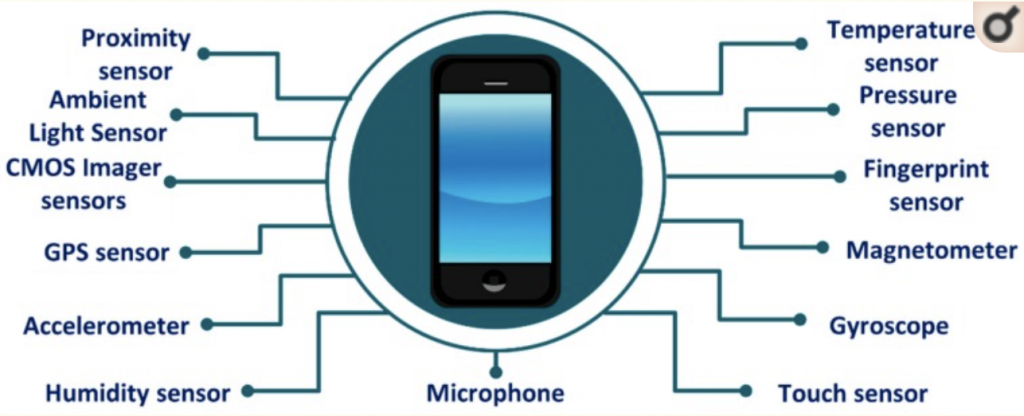Over the past few years, medical diagnostic apps are on the rise. Rapidly emerging technologies used to diagnose diseases result in more personalized patient care. About 70% of medical decisions are supported by diagnostics [2]. However, short of specialists and relatively low diagnostic accuracy calls for a new way of diagnostic strategy, in which deep learning may play a significant role. Smartphones and wearable devices can play a key role in health monitoring and diagnostics. They already support remote diagnostics and decrease the workload of GPs.
Diagnostic Apps
Modern smartphones are fitted with several sensors. These sensors allow for the sensing of several health parameters and health conditions.

Respiratory sounds are important indicators of respiratory health and respiratory disorders. When a person breathes, the sound emitted is directly related to air movement, changes within lung tissue, and the position of secretions within the lung. Depending on the sound, it is possible to monitor asthma, to record respiratory sounds for snoring and sleep apnea severity, detect respiratory symptoms like sneeze and cough, to detect bronchitis, bronchiolitis, and pertussis, to record wheezes in pediatric populations, and to detect the chronic obstructive pulmonary disease (COPD).
Leukocoria is an abnormal white reflection from ophthalmologists’ retina to detect several different eye diseases. As well as being an early indication of retinoblastoma, a pediatric eye cancer, leukocoria can also be a sign of pediatric cataract, Coats’ disease, amblyopia, strabismus, and other childhood eye disorders [4]. A portable 3d-printed device connected to a smartphone makes precise images of the retina to detect back-of-the-eye (fundus) disease at a far lower cost than conventional methods [3]. It is also possible to analyze images of the eye taken with this retinal camera to detect diabetic retinopathy, one of the leading causes of blindness.
Heart rate variability (HRV) is a measure of variations in the time intervals between your heartbeats and describes how “uneven” your heart beats. This metric can be used for different purposes:
- to measure stress levels
- to diagnose chronic health problems
- to assess the immune system
- to predict the recovery time after a severe illness
Ear and mastoid disease can easily be treated by early detection and appropriate medical care.
Skin diseases are widespread nowadays and spreading widely among people. The resolution of smartphone cameras has such a high resolution nowadays that these kinds of diseases can be detected [5].
In the modern world, psychological health issues like anxiety and depression have become very common among the masses. Smartphone technology can be used to diagnose depression and anxiety [2].
And this is not the end of the medical usage of smartphones. Future sensors for analyzing sweat, isoline levels, and more are coming and will support more diagnostic applications for smartphones and wearables.
Datasets
The lack of large training data sets is often mentioned as an obstacle. However, this is only partially correct. Nowadays, hospitals are huge data storages, and databases in, e.g., radiology, are filled with millions of images. There are also large public data sets available on the internet.
What ML model for what task?
A survey name ‘A Survey on Deep Learning in Medical Image Analysis’ concluded that the exact deep learning architecture is not the most important determinant in getting a good solution. More important is expert knowledge about the task that can provide advantages beyond adding more layers to a CNN. Novel data preprocessing strategies also contribute to more accurate and more robust neural networks [6].
Problems
There remain still some problems with the accuracy of such systems. 98% accuracy of a diagnostic system can be quite expressing, but when we scale this up to a user base of millions, we could overrun our health systems with wrong diagnosed patients. So it is essential to make these diagnostic systems more and more robust.
References
[1] Majumder, Sumit, and M. Jamal Deen. “Smartphone sensors for health monitoring and diagnosis.” Sensors 19.9 (2019): 2164.
[2] https://www.bupa.com/newsroom/our-views/the-future-of-diagnostics
[3] https://medicalxpress.com/news/2019-06-portable-device-eye-disease-remotely.html
[4] Munson, Micheal C., et al. “Autonomous early detection of eye disease in childhood photographs.” Science advances 5.10 (2019): eaax6363.
[5] Chan, Stephanie, et al. “Machine Learning in Dermatology: Current Applications, Opportunities, and Limitations.” Dermatology and therapy (2020): 1-22.
[6] Litjens, Geert, et al. “A survey on deep learning in medical image analysis.” Medical image analysis 42 (2017): 60-88.